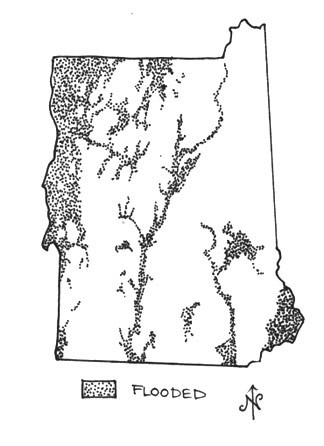
For those of you who view geology as a confusing bunch of stones from the ancient past, try this: Vermont has an income tax and New Hampshire doesn’t because Vermont is landlocked while New Hampshire isn’t.
This statement is practically true – “practically” because human affairs are rarely straightforward enough to be solely determined by nature. But this disclaimer aside, geology has played a major role in taxation in the two states.
The geological force in question is called isostatic rebound. The earth beneath our feet is actually a thin crust of solid rock that floats on a mantle of molten rock below. When extra weight is added on top, the crust is pressed down and floats lower on the mantle. When the weight is removed, the crust rebounds to its original level. It’s like the older cousin who swims out to your raft one summer afternoon and nearly sinks it climbing on. Once the cousin swims away, your raft floats back up, high and dry.
In Vermont and New Hampshire, the added weight on the crust came from the ice of the last ice age. These continental glaciers were several miles thick. Considering that the crust beneath them is only a dozen or so miles thick, the extra weight was significant.
The crucial fact for the twin states is that the ice sheet was far thicker over present day Burlington, Vermont, than over Portsmouth, New Hampshire, because northwest Vermont was significantly closer to the center of continental glaciation at Hudson Bay. The ice slowly melted and thinned as it slid from Canada to coastal New England, and thinned especially rapidly near the open waters of the Atlantic Ocean. The result is that Burlington floated roughly 500 feet lower during the ice age than it does today, while Portsmouth floated about 50 feet lower.
Picture the Champlain Valley 500 feet lower than today, and then check the current elevation of Burlington: only about 100 feet above sea level. At the end of the last ice age, when the glaciers melted completely out of Vermont and New Hampshire, Burlington was roughly 400 feet beneath the waves of the Atlantic. Both Vermont and New Hampshire were coastal states; Vermont’s coastline was the western edge of the Green Mountains while New Hampshire’s was inland near Epping. All New England was an island whose “west coast” was the Champlain Valley.
Before you dismiss this as something from the dim recesses of time, keep in mind that these events occurred during human history. The ice melted out of the twin states about 10,000 years ago, a time when human beings were hunting giant mammals on the tundra along the ice’s edge. Because the earth’s crust took thousands of years to float back up to its original place atop the mantle, it is likely that Vermont remained a coastal state until roughly 3,000 B.C.
What if both Vermont and New Hampshire had been coastal when the European explorers arrived in North America? The English would have sailed directly to New Hampshire, as they later did, but also might have sailed their ocean-going vessels up the Hudson into the Champlain valley, still salty. More likely, the French would have sailed up the St. Lawrence and Richelieu valleys and straight into Vermont, establishing Montreal not at the end of the navigable St. Lawrence but perhaps near Montpelier.
That isn’t how it worked, of course. Even though Vermont had only risen above the waves a moment before, geologically speaking, when the European migration began, New Hampshire had a seacoast and Vermont did not. English settlers working their way inland from the coast established permanent settlements in New Hampshire nearly 150 years before they did in Vermont. Largely because one state was coastal and the other landlocked.
So how did all this affect taxation? The constitutions of both states were written in the late 1700s. New Hampshire by that time had nearly two centuries of English settlement history, with a diverse economy and settlement pattern that ranged from wealthy merchants in Portsmouth to homestead farmers in the interior. Their constitution insured that no one group would easily dominate any other. In Vermont, meanwhile, with only two decades of settlement history and an economy based entirely on homestead farmers, the constitution granted power to these farmers and the small towns they lived in.
Fast forward to the 1920s and 30s, when both states were considering a personal income tax. In Vermont, the farmers and their small-town allies were able to enact the tax despite the objections of their urban brethren in Burlington and Rutland. In New Hampshire, 60 percent of the state’s residents voted in favor of an income tax in a 1929 referendum. Not enough. The state constitution – designed to balance the interests of the coast and the interior, the urban and the rural – specified a two-thirds majority for enacting such a tax.

